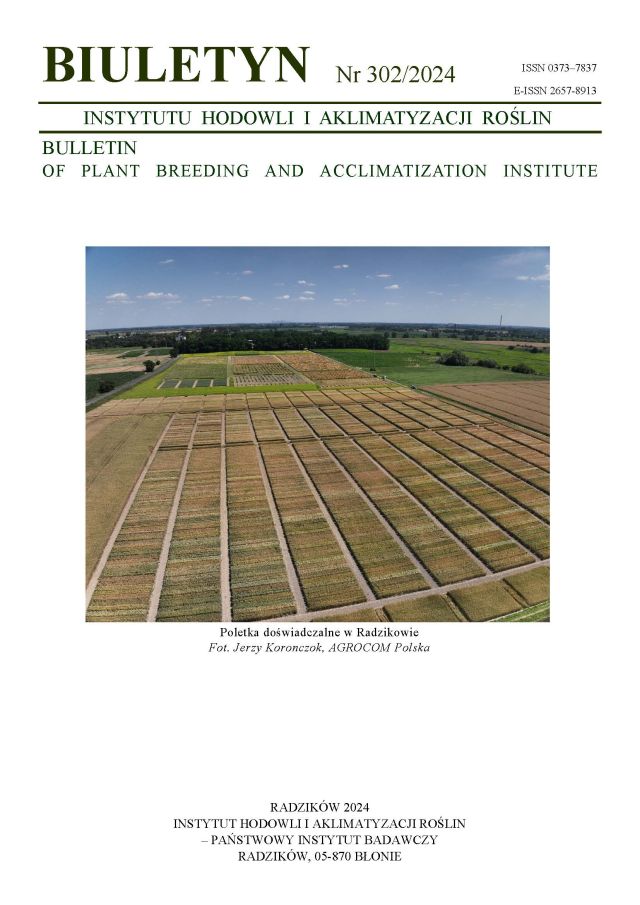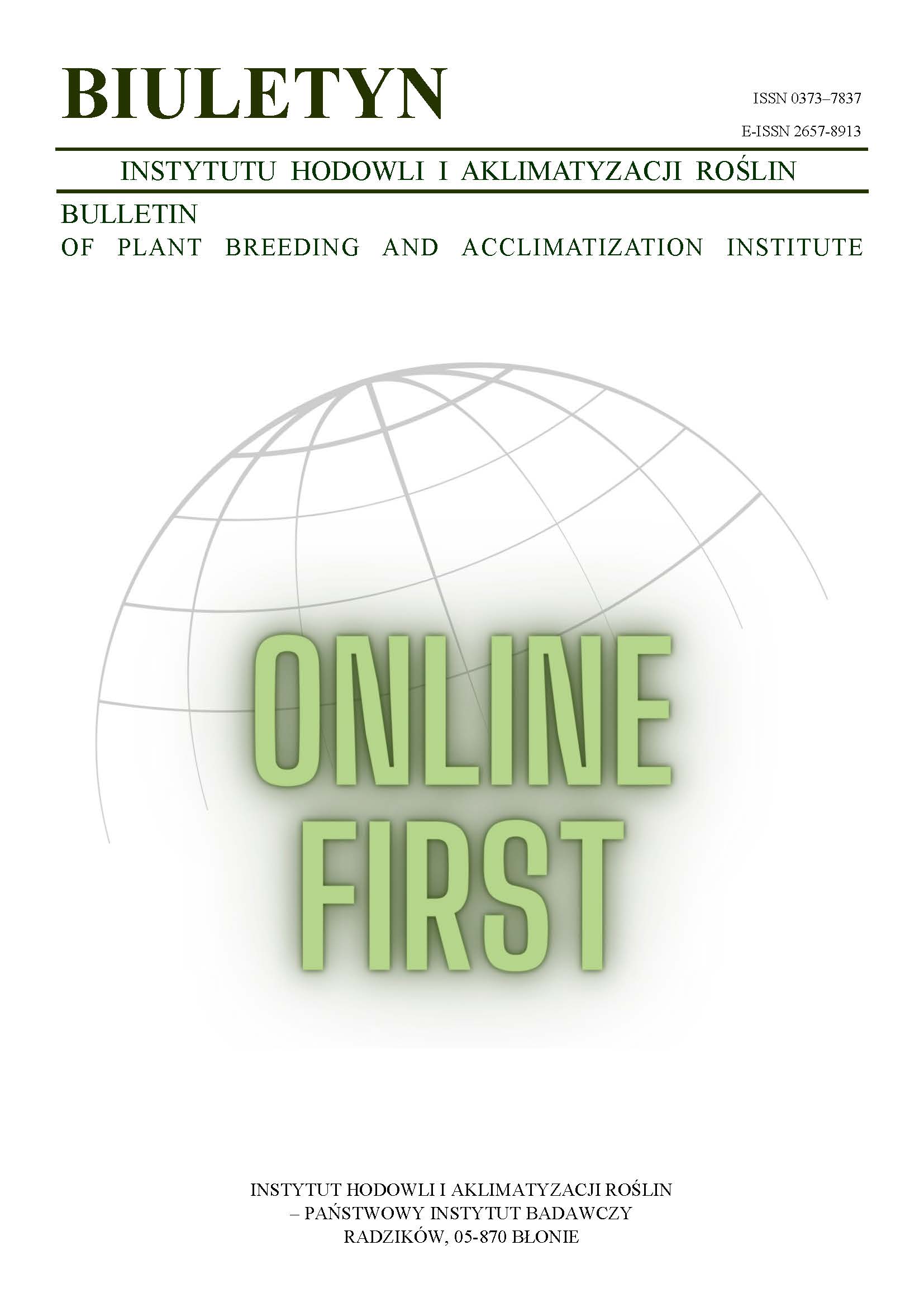Characterization of yielding traits in the dwarf mutant of common bean (Phaseolus vulgaris L.) in relation to the ancestor Bor cultivar
Jolanta Ziemiańska
iro@uph.edu.plKatedra Hodowli Roślin i Nasiennictwa, Akademia Podlaska, Siedlce (Poland)
Abstract
Two biotypes of common bean (Phaseolus vulgaris L.): the Bor cultivar and the dwarf mutant of this Bor cultivar, which was obtained as a result of irradiation of early dry seeds by γ-rays, were used as an experimental material. The experiments were carried out in 1999–2001 using the method of randomized blocks in 6 replications. The results of biometrical measurements were applied to estimate variation of some yielding traits by means of mean values and the analysis of variance. The detailed comparison between arithmetic means was conducted with the Tukey’s test at P 0,05. The results of 3-years experiments allowed to state that the dwarf mutant differed significantly from the initial Bor cultivar in regard to lower seed yield, number of seeds per plant, number of pods, number of seeds per pod and lower thousand seeds weight. The mutants were characterized by larger total protein content in seeds.
Keywords:
common bean, mutation, variability, yielding traits, γ-raysReferences
Abreu A. de F. B., Ramalho M. A. P., Ferreira D. F. 1999. Selection potential for seed yield from intra- and inter-racial populations. Euphytica 108: 121 — 127.
DOI: https://doi.org/10.1023/A:1003608310384
Google Scholar
AOAC. 1955. Association of Official Analytical Chemists, Official Methods of Analysis, Washington DC.
Google Scholar
Belele C. L., Vieira G. S., Goulart L. R. 2001. Effects of gamma radiation on morphological traits and seed storage proteins of bean. Mutation Breeding Newsletter 45: 23.
Google Scholar
Bhatia C. R., Małuszyński M., Nichterlein K., Van Zanten L. 2001. Grain legume cultivars from induced mutations and mutations affecting nodulation. Mutation Breeding Review No 13.
Google Scholar
Boros L., Szyrmer J., Sawicki J., Marcinkowska J. 1994. Analiza stabilności plonu nasion i cech użytkowych wybranych odmian i rodów fasoli karłowej (Phaseolus vulgaris L.) na suche nasiona. Ogólnopolska Konf. Nauk. Strączk. Rośl. Białk. Cz. I. Fasola, Lublin, 25 Listopada: 99 — 103.
Google Scholar
Escribano M. R., De Ron A. M., Amurrio J. M. 1994. Diversity in agronomical traits in common bean populations from northwestern Spain. Euphytica 76: 1 — 6.
DOI: https://doi.org/10.1007/BF00024014
Google Scholar
Hołubowicz R., Bralewski T. W., Fiebig M., Bocian S. 2004. Variability of selected characters of 18 local populations of bean (Phaseolus ssp.). Electronic Journal of Polish Agricultural Universities, Horticulture, Vol. 7/1, www.ejpau.media.pl.
Google Scholar
Kelly J. D., Kolkman J. M., Schneider K. 1998. Breeding for yield in dry bean (Phaseolus vulgaris L.). Euphytica 102: 343 — 356.
DOI: https://doi.org/10.1023/A:1018392901978
Google Scholar
Łabuda H., Papliński R. 2005. Ocena nowych odmian fasoli zwykłej i fasoli wielokwiatowej na suche nasiona. Zmienność genetyczna i jej wykorzystanie w hodowli roślin ogrodniczych. Monografia. Praca zbiorowa pod redakcją Michalik B., Żurawicz E.: 161 — 166.
Google Scholar
Łabuda H., Witek A. 2004. Charakterystyka ważniejszych cech użytkowych kilkunastu odmian fasoli na suche nasiona. Folia Univ. Agric. Stetin.. Agricultura 239 (95):217 — 222.
Google Scholar
Martyniak J. 1998. Wykorzystanie materiałów wyjściowych w hodowli polskich odmian roślin strączkowych. Zesz. Prob. Post. Nauk Rol. 463: 575 — 590.
Google Scholar
Milczyńska E. 1998. Syntezy wyników odmianowych. Warzywa strączkowe. 1997. z. 1124.
Google Scholar
Nichterlein K. 1999. The role of induced mutations in the improvement of common beans (Phaseolus vulgaris). Mutation Breeding Newsletter 44: 6 — 9.
Google Scholar
Szyrmer J., Dembińska J., Wawer A., 1992. Przebieg wegetacji i zmienność cech użytkowych odmian i form Phaseolus vulgaris L. Biul. IHAR 180: 229 — 239.
Google Scholar
Trętowski J., Wójcik A. L. 1991. Metodyka doświadczeń rolniczych. WSRP Siedlce.
Google Scholar
Witek A., Kotlińska T., Witek Z. 1998. Waloryzacja genotypów fasoli zwykłej (Phaseolus vulgaris L.) na suche ziarno. Zesz. Prob. Post. Nauk Rol. 463: 481 — 489.
Google Scholar
Authors
Jolanta Ziemiańskairo@uph.edu.pl
Katedra Hodowli Roślin i Nasiennictwa, Akademia Podlaska, Siedlce Poland
Statistics
Abstract views: 59PDF downloads: 18
License
Copyright (c) 2006 Jolanta Ziemiańska

This work is licensed under a Creative Commons Attribution-ShareAlike 4.0 International License.
Upon submitting the article, the Authors grant the Publisher a non-exclusive and free license to use the article for an indefinite period of time throughout the world in the following fields of use:
- Production and reproduction of copies of the article using a specific technique, including printing and digital technology.
- Placing on the market, lending or renting the original or copies of the article.
- Public performance, exhibition, display, reproduction, broadcasting and re-broadcasting, as well as making the article publicly available in such a way that everyone can access it at a place and time of their choice.
- Including the article in a collective work.
- Uploading an article in electronic form to electronic platforms or otherwise introducing an article in electronic form to the Internet or other network.
- Dissemination of the article in electronic form on the Internet or other network, in collective work as well as independently.
- Making the article available in an electronic version in such a way that everyone can access it at a place and time of their choice, in particular via the Internet.
Authors by sending a request for publication:
- They consent to the publication of the article in the journal,
- They agree to give the publication a DOI (Digital Object Identifier),
- They undertake to comply with the publishing house's code of ethics in accordance with the guidelines of the Committee on Publication Ethics (COPE), (http://ihar.edu.pl/biblioteka_i_wydawnictwa.php),
- They consent to the articles being made available in electronic form under the CC BY-SA 4.0 license, in open access,
- They agree to send article metadata to commercial and non-commercial journal indexing databases.
Most read articles by the same author(s)
- Małgorzata Wyrzykowska, Jolanta Ziemiańska, Marzena Lisowska, Variability and correlations of some traits in lucerne (Medicago sativa ssp. L.) forms with different length of inflorescence , Bulletin of Plant Breeding and Acclimatization Institute: No. 246 (2007): Regular issue














